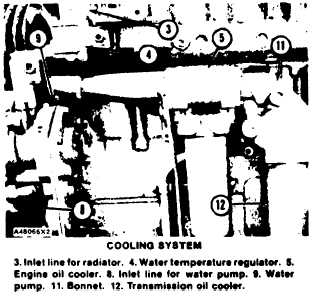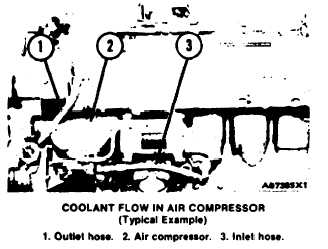COOLING SYSTEM
SYSTEMS OPERATION
TM 5-3805-263-14&P-2
The internal bypass (10) has another function
when the cooling system is being filled. It lets the
coolant go into cylinder head (6) and cylinder block
(7) without going through water pump (9).
Radiator (2) has a pressure relief cap or a relief
valve and filler cap. The pressure relief cap or valve
keeps the pressure in the cooling system from getting
too high when the engine is running. It also lets air
come into the system when the pressure in the system
is less than atmospheric.
tors into cylinder head (6). The water directors send
the flow of coolant around the valves and the pas-
sages for exhaust gases in cylinder head (6). The
coolant goes to the front of cylinder head (6). Here
water temperature regulator (4) controls the direc-
tion of the flow. If the coolant temperature is less
than normal for engine operation. water temperature
regulator (4) is closed. The only way for the coolant
to get out of cylinder head (6) is through internal
bypass (10). The coolant from this line goes into
water pump (9) which pushes it through the cooling
system again. The coolant from internal bypass (10)
also works to prevent cavitation (air bubbles) in the
coolant. When the coolant gets to the correct temper-
ature. water temperature regulator (4) opens and
coolant flow is divided. Most of the coolant goes
through the radiator (2) for cooling. The remainder
goes through internal bypass (10) to water pump (9).
The amount of the two flows is controlled by water
temperature regulator (4).
NOTE: The water temperature regulator is an im-
portant part of the cooling system. It divides coolant
flow between the radiator (2) and the internal bypass
(10) as necessary to maintain the correct operating
temperature. If the regulator is not installed in the
system. there is no mechanical control and most of
the coolant will follow the path of least resistance
thru the internal bypass (10). This will cause the
engine to overheat in hot weather. In cold weather,
even the small amount of coolant that goes thru the
radiator (2) is too much and the engine will not get to
normal operating temperature.
Water Pump
The centrifugal-type water pump has two seals.
One prevents leakage of water and the other prevents
leakage of lubricant.
An opening in the bottom of the pump housing
allows any leakage at the water seal or the rear
bearing oil seal to escape.
Fan
The fan is driven by two V-belts, from a pulley on
the crankshaft. Belt tension is adjusted by moving
the clamp assembly which includes the fan mounting
and pulley.
COOLANT FOR AIR COMPRESSOR
The coolant for the air compressor (2) comes
from the cylinder block through hose (3) and into
the air compressor. The coolant goes from the air
compressor through hose (1) back into the front of
the cylinder head.
1-19




